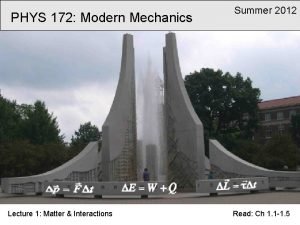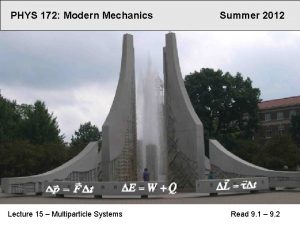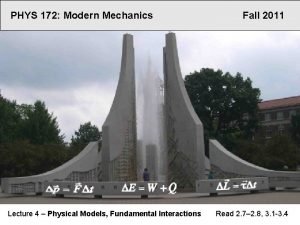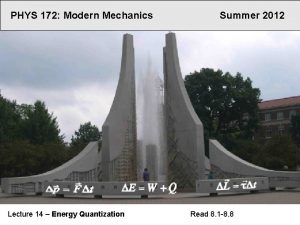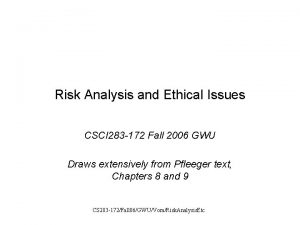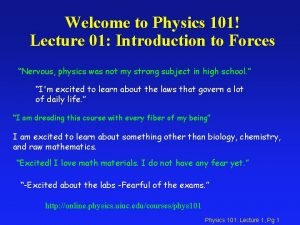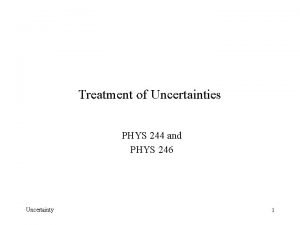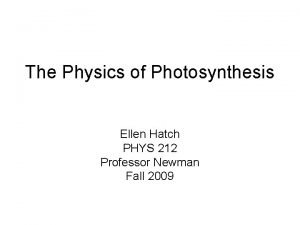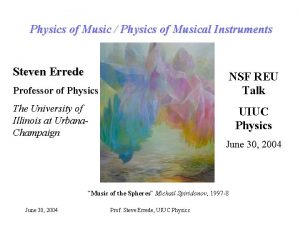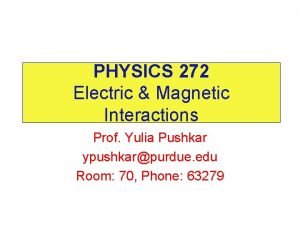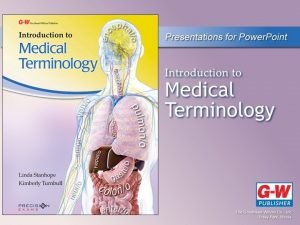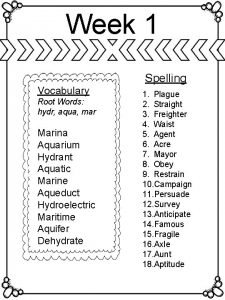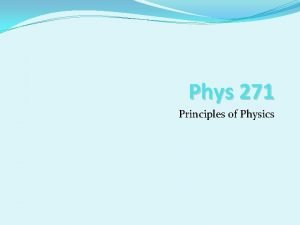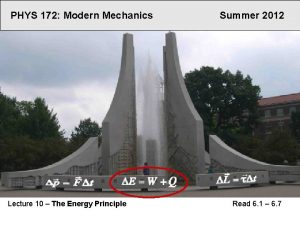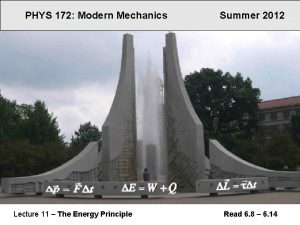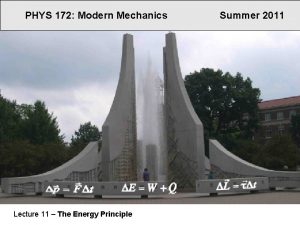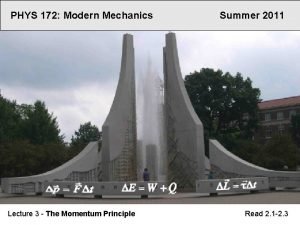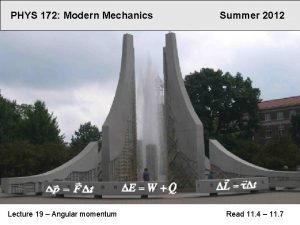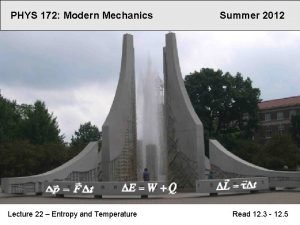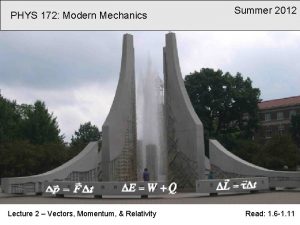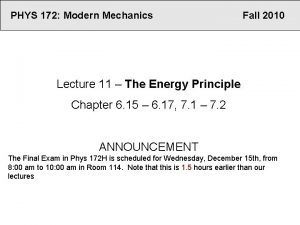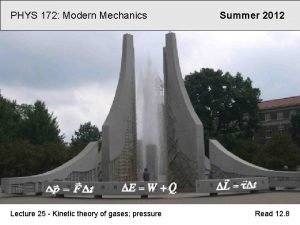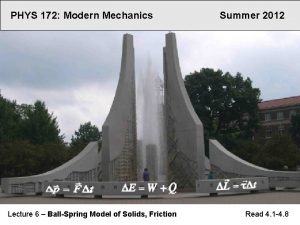PHYS 172 Modern Mechanics Lecture 9 The Energy




















- Slides: 20

PHYS 172: Modern Mechanics Lecture 9 – The Energy Principle Fall 2011 Read 6. 1 – 6. 7

TODAY • The Energy Principle • Energy is Conserved • Rest Energy and Kinetic Energy • Work =

What Is Energy? Energy is just some number you can compute that obeys a conservation law. It’s helpful book-keeping. (See Feynman Lectures on Physics, Vol. 1, Sec. 4 -1) Why Introduce Energy? Without following the details of a complicated process, we can: • say something about initial and final states of a system • predict whether some process CAN occur Basically, for some problems, using energy is much simpler than using the momentum principle. Often, however, we’ll use both principles in combination.

The Energy Principle “effect” “cause” (due to interactions) * We mean the Work done ON a System by a Force in the Surroundings* Compare With Momentum Principle: “effect” “cause” (due to interactions) NOTE: Momentum is a vector. Energy is a scalar (no direction).

Energy is A Conserved Quantity Energy is a useful thing to consider because energy can’t be destroyed: it can only change forms. Compare with Conservation of Momentum: Reminder: Momentum is a vector. Energy is a scalar (no direction).

Energy of a Single Particle System Experimentally, this is the expression that works in a conservation law

Rest Energy A particle at rest has some energy just because it exists! Rest energy = mc 2.

Kinetic Energy mc 2 Excess energy above rest energy (mc 2) is due to motion (ignoring internal degrees of freedom):

Kinetic Energy What? ? What happened to At low velocities, Use a Taylor expansion (power series): ?

Energy And Momentum Use ALWAYS TRUE. EVERY REFERENCE FRAME.

Energy and Force It takes twice as much energy to raise a heavy box a distance 2 h, compared to lifting it only h. Thus, it is distance that seems to matter, not time. Does this match your real-world experience?

Energy and Force It takes twice as much energy to raise a heavy box a distance 2 h, compared to lifting it only h. Thus, it is distance that seems to matter, not time. WORK due to mechanical energy transfer: In more general vector notation, this is: * We mean the Work done ON a System by a Force in the Surroundings*

Force at an angle y Only x-component of force “works”! Definition of work x Force component along the path of motion

Work as a dot product Dot product: y x 14

Sign of Work Circular orbit Earth does no work on the Moon. Sun does work on comet, speeding it up.

Game: What’s the Sign of the Work? * We mean the Work done ON a System by a Force in the Surroundings*

What Causes The Energy of A System to Change? Reminder: Momentum Principle Interactions: some Psurroundings transforms into Psystem. Forces transfer momentum from one object to another. Energy can be transferred from the surroundings to a system in two ways: • Energy transfer by heat (next chapter) • Energy transfer by work set = 0 for now

Example You hold a ball of mass 0. 5 kg at rest in your hand throw it forward so that it leaves your hand at speed 20 m/s. How much work did you do on the ball? vi = 0 m/s vf = 20 m/s Rest energy did not change

Change of identity – change of rest energy How much kinetic energy do the products have? =0 Neutron decay An electron-volt (e. V) unit: 1 e. V = 1. 6 10 -19 J 1 Me. V = 106 e. V 1 Volt >0 Mass of products is smaller than mass of reactant! Mass is converted into kinetic energy

WHAT WE DID TODAY • The Energy Principle • Energy is Conserved • Rest Energy and Kinetic Energy • Work =
 Phys 172
Phys 172 Particl clicker
Particl clicker Phys 172
Phys 172 Phys 172
Phys 172 283+172
283+172 Physics 241
Physics 241 01:640:244 lecture notes - lecture 15: plat, idah, farad
01:640:244 lecture notes - lecture 15: plat, idah, farad Energy energy transfer and general energy analysis
Energy energy transfer and general energy analysis Energy energy transfer and general energy analysis
Energy energy transfer and general energy analysis Uiuc physics 102
Uiuc physics 102 Physics 101 uiuc
Physics 101 uiuc Ucsd physics courses
Ucsd physics courses Calculating percent difference
Calculating percent difference Http //www.phys.hawaii.edu/ teb/optics/java/slitdiffr/
Http //www.phys.hawaii.edu/ teb/optics/java/slitdiffr/ Wave optics topics
Wave optics topics Phys 212 equation sheet
Phys 212 equation sheet Phys 398 uiuc
Phys 398 uiuc Si units for charge
Si units for charge Define ostealgia
Define ostealgia Hex root words
Hex root words Mastering physics login
Mastering physics login
